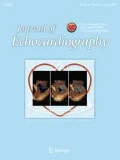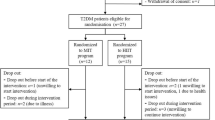Abstract
Background
No relationship between the ratio of peak early velocity of left ventricular inflow to peak systolic longitudinal velocity of the mitral annulus velocity (E/e′) and insulin resistance has yet been shown in patients with cardiac disease. We hypothesized that patients with high E/e′ values would tend not to show the rapid blood glucose-lowering in response to exercise training characteristic of impaired glucose tolerance (IGT) or diabetes mellitus (DM) patients.
Methods
The subjects were continuous IGT/DM patients (n = 27) participating in cardiac rehabilitation. All patients’ E/e′ values were measured by echocardiography. The patients’ blood glucose levels (mg/dl) were measured just before (pre-BS) and after (post-BS) exercise training. Post-BS was subtracted from pre-BS to obtain ΔBS, and the relationship between E/e′ and ΔBS was investigated.
Results
E/e′ correlated negatively with ΔBS. Moreover, E/e′ was a significant predictor of ΔBS and as such was independent of hemoglobin A1c (HbA1c), pre-BS, and presence of atrial fibrillation on multivariate analysis.
Conclusions
Patients with high E/e′, indicating high left ventricular filling pressure, were unlikely to exhibit the rapid glucose-lowering response.

Similar content being viewed by others
References
Boulé NG, Haddad E, Kenny GP, et al. Effects of exercise on glycemic control and body mass in type 2 diabetes mellitus: a meta-analysis of controlled clinical trials. JAMA. 2001;286:1218–27.
Snowling NJ, Hopkins WG. Effects of different modes of exercise training on glucose control and risk factors for complications in type 2 diabetic patients: a meta-analysis. Diabetes Care. 2006;29:2518–27.
Hayashi T, Wojtaszewski JF, Goodyear LJ. Exercise regulation of glucose transport in skeletal muscle. Am J Physiol. 1997;273:1039–51.
Musi N, Fujii N, Hirshman MF, et al. AMP-activated protein kinase (AMPK) is activated in muscle of subjects with type 2 diabetes during exercise. Diabetes. 2001;50:921–7.
Dela F, Handberg A, Mikines KJ, et al. GLUT 4 and insulin receptor binding and kinase activity in trained human muscle. J Physiol. 1993;469:615–24.
Church TS, Blair SN, Cocreham S, et al. Effects of aerobic and resistance training on hemoglobin A1c levels in patients with type 2 diabetes: a randomized controlled trial. JAMA. 2010;20:2253–62.
Nagueh SF, Middleton KJ, Kopelen HA, et al. Doppler tissue imaging: a noninvasive technique for evaluation of left ventricular relaxation and estimation of filling pressures. J Am Coll Cardiol. 1997;30:1527–33.
Ommen SR, Nishimura RA, Appleton CP, et al. Clinical utility of Doppler echocardiography and tissue Doppler imaging in the estimation of left ventricular filling pressures: a comparative simultaneous Doppler-catheterization study. Circulation. 2000;102:1788–94.
Oki T, Tabata T, Yamada H, et al. Clinical application of pulsed Doppler tissue imaging for assessing abnormal left ventricular relaxation. Am J Cardiol. 1997;79:921–8.
Yamada H, Oki T, Mishiro Y, et al. Effect of aging on diastolic left ventricular myocardial velocities measured by pulsed tissue Doppler imaging in healthy subjects. J Am Soc Echocardiogr. 1999;7:574–81.
Hillis GS, Møller JE, Pellikka PA, et al. Noninvasive estimation of left ventricular filling pressure by E/e’ is a powerful predictor of survival after acute myocardial infarction. J Am Coll Cardiol. 2004;43:360–7.
Schiller NB, Acquatella H, Ports TA, et al. Left ventricular volume from paired biplane two-dimensional echocardiography. Circulation. 1979;60:547–55.
Oh JK, Appleton CP, Hatle LK, et al. The noninvasive assessment of left ventricular diastolic function with two-dimensional and Doppler echocardiography. J Am Soc Echocardiogr. 1997;10:246–70.
Sohn DW, Song JM, Zo JH, et al. Mitral annulus velocity in the evaluation of left ventricular diastolic function in atrial fibrillation. J Am Soc Echocardiogr. 1999;11:927–31.
Izawa KP, Watanabe S, Osada N, et al. Handgrip strength as a predictor of prognosis in Japanese patients with congestive heart failure. Eur J Cardiovasc Prev Rehabil. 2009;16:21–7.
Triposkiadis F, Karayannis G, Giamouzis G, et al. The sympathetic nervous system in heart failure physiology, pathophysiology, and clinical implications. J Am Coll Cardiol. 2009;54:1747–62.
Ashrafian H, Frenneaux MP, Opie LH. Metabolic mechanisms in heart failure. Circulation. 2007;116:434–48.
Kemppainen J, Tsuchida H, Stolen K, et al. Insulin signalling and resistance in patients with chronic heart failure. J Physiol. 2003;550:305–15.
Lund S, Holman GD, Schmitz O, et al. Contraction stimulates translocation of glucose transporter GLUT4 in skeletal muscle through a mechanism distinct from that of insulin. Proc Natl Acad Sci USA. 1995;92:5817–21.
Opie LH. The metabolic vicious cycle in heart failure. Lancet. 2004;364:1733–4.
Musi N, Fujii N, Hirshman MF, et al. AMP-activated protein kinase (AMPK) is activated in muscle of subjects with type 2 diabetes during exercise. Diabetes. 2001;50:921–7.
Tabony AM, Yoshida T, Galvez S, et al. Angiotensin II upregulates protein phosphatase 2Cα and inhibits AMP-activated protein kinase signalling and energy balance leading to skeletal muscle wasting. Hypertension. 2011;58:643–9.
Al-Hesayen A, Azevedo ER, Floras JS, et al. Selective versus non-selective beta-adrenergic receptor blockade in chronic heart failure: differential effects on myocardial energy substrate utilization. Eur J Heart Fail. 2005;7:618–23.
Vermes E, Tardif JC, Bourassa MG, et al. Enalapril decreases the incidence of atrial fibrillation in patients with left ventricular dysfunction: insight from the studies of left ventricular dysfunction (SOLVD) trials. Circulation. 2003;107:2926–31.
Yusuf S, Ostergren JB, Gerstein HC, et al. Candesartan in heart failure-assessment of reduction in mortality and morbidity program investigators. Effects of candesartan on the development of a new diagnosis of diabetes mellitus in patients with heart failure. Circulation. 2005;112:48–53.
Conflict of interest
There is no conflict of interest from any party.
Author information
Authors and Affiliations
Corresponding author
Rights and permissions
About this article
Cite this article
Fukuda, Y., Yoshimura, K., Fukuda, Y. et al. High E/e′ disrupts the rapid lowering of blood glucose in response to exercise training. J Echocardiogr 10, 119–124 (2012). https://doi.org/10.1007/s12574-012-0134-0
Received:
Revised:
Accepted:
Published:
Issue Date:
DOI: https://doi.org/10.1007/s12574-012-0134-0




